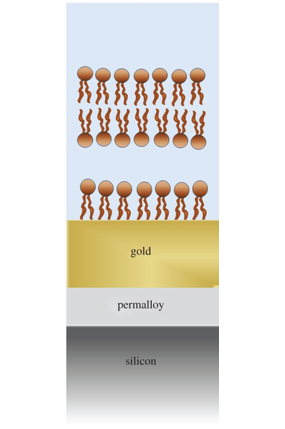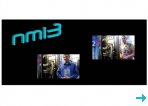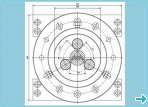Biosensors will benefit from new method to produce membranes
NMI3 collaboration has taken a significant step in the production of biological membranes.
Inês Crespo, Information Manager, 01/12/2014

Scheme of the FSB fabricated by the group
All cells in our body are surrounded by membranes, usually a phospholipid bilayer. It is thus important to study biological membranes as they can be used for instance to investigate new sensor technologies that could support the delivery of medicines to our body or to diagnose diseases.
To make them easier to study scientists are working on new ways to immobilise membranes on solid substrates. They use floating supported bilayers (FSBs) as these do not interact with the substrate. However FSBs can be unstable and little dense, making them difficult to immobilise. Thanks to the NMI3 Joint Research Activity on Tools for Soft and Bio-Materials , a group of scientists have proposed a new approach to produce FSBs so that the situation can finally be improved.
By using gold and magnetic layers to enhance their neutron reflectivity experiments, they made great progress in producing a lipid bilayer. The first layer (SAM ‒ a self-assembled monolayer) was completely formed whereas the second layer was a stable FSB that covered the first layer almost completely.
This new approach is a significant step forward on the fabrication of FSBs as it is simple, stable and able to create complete layers. These findings might open new doors in the field of medicine.
Original publication
Hughes AV, Holt SA, Daulton E, Soliakov A, Charlton TR, Roser SJ, Lakey JH (2014), High coverage fluid-phase floating lipid bilayers supported by ω-thiolipid self-assembled monolayers, J R Soc Interface, 11(98):20140447. DOI: 10.1098/rsif.2014.0447.
NMI3 thanks A.V. Hughes for reviewing this article.
Highlights from this JRA
New humidity chamber will shed light on processes behind Alzheimer’s disease
A JRA supported by NMI3 is working on a new humidity chamber. The instrument will be used for neutron scattering experiments to reproduce the human body conditions in order to shed light on biological processes such as the development of Alzheimer’s disease. Check out our video and article here !
Improving neutron scattering data quality: a multi-angle light scattering setup
During a neutron scattering experiment the sample might degrade and produce wrong results. In our new video, researchers explain their work on a set up to control the sample quality along time so that false data can be discarded. This work will improve the data quality. You can see the video and read the article here .
To broaden research possibilities: a new pressure cell
Henrich Frielinghaus and Marie-Sousai Appavou from the JCNS-MLZ are developing a new pressure cell. This work, which is funded by NMI3, will broaden the research possibilities in several scientific fields. You can read the article here .




